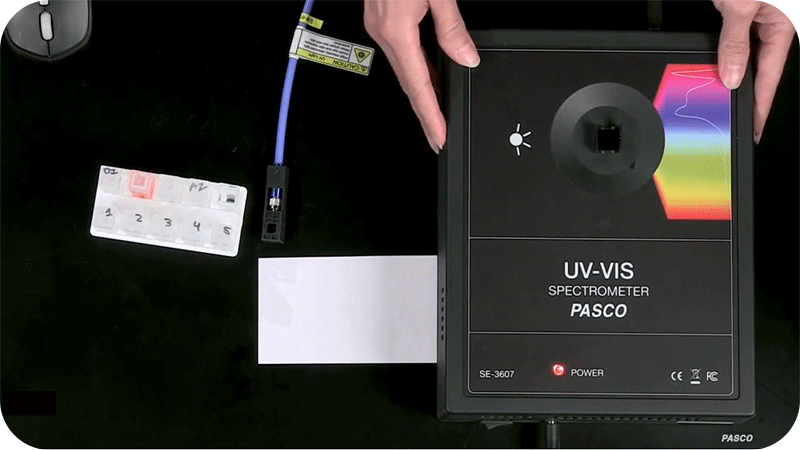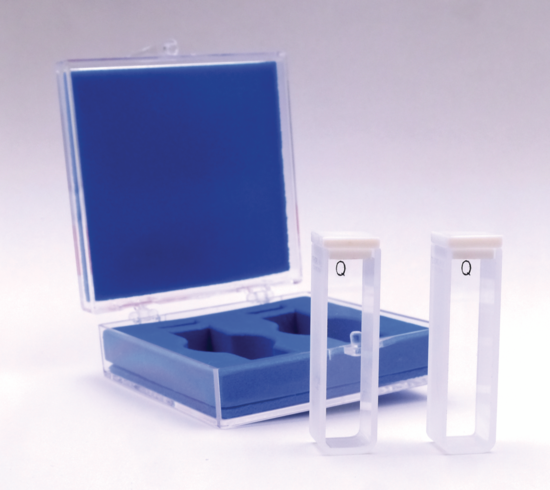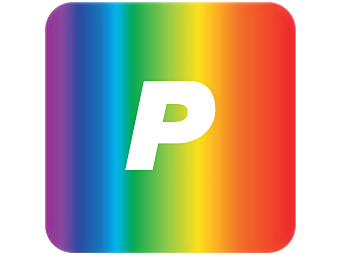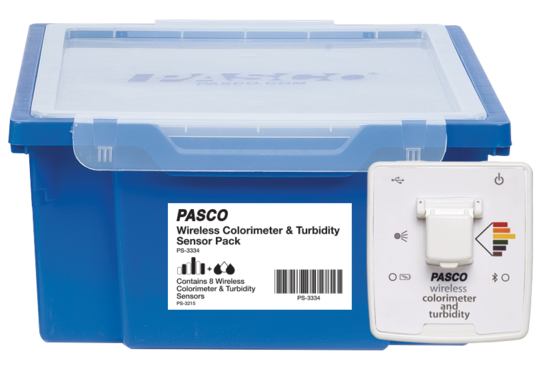
Spectrometers
A spectrometer is a device that allows scientists to dissect light into its constituent colors, akin to separating the vibrant hues of a rainbow. By precisely dispersing the light, spectrometers provide a unique window into the physical and chemical properties of objects.
They aid in a wide range of scientific endeavors, from studying the chemical composition of stars to monitoring the environment. (To dive deeper into the history of spectroscopy–dating all the way back to Sir Isaac Newton–check out our article, Who Discovered Spectroscopy?)
In this guide, we’ll cover our available spectrometers:
How Do Spectrometers Work?
Spectrometers analyze the behavior of light–or more specifically, the behavior of electromagnetic radiation (EM), which describes all kinds of light: radio waves, microwaves, infrared light, ultraviolet light, gamma rays, and x-rays.

When light interacts with matter (or matter emits light), whether it’s a star, gas cloud, or laboratory sample, it imparts a wealth of information observable through spectroscopy. By examining the specific wavelengths of light an object emits or absorbs, scientists can deduce the elemental composition, temperature, velocity, and even the presence of exotic molecules or atoms in the target of their study. For more information on spectroscopy and the electromagnetic spectrum, make sure to visit our product guide, What is Spectroscopy?
As technology advances, spectrometers continue to evolve, becoming more sensitive, precise, and versatile. Modern spectrometers, both ground-based and space-based, can capture light across a never-before-observed range of wavelengths with exquisite resolution. They leverage the power of advanced detectors, computer algorithms, and data processing techniques to reveal intricate details about the universe's tapestry.
Common Applications
- Analyze the absorption spectrum
- Demonstrate Beer’s Law
- Investigate enzyme activity
- Study kinetics
- Quantify DNA and RNA
- Determine equilibrium constants
- Measure the speed of a reaction
- Study atomic structure
- Determine the concentration of ions
- Perform purified protein analysis
- Run colorimetric assays
- And much more!
 A spectrometer analyzes extracted compounds from various citrus juices.
A spectrometer analyzes extracted compounds from various citrus juices. A wireless spectrometer is used in a biology lab and the data is streamed to a tablet to easily analyze the resulting wavelengths.
A wireless spectrometer is used in a biology lab and the data is streamed to a tablet to easily analyze the resulting wavelengths.
UV-Vis Spectrometer
The PASCO UV-Vis Spectrometer (SE-3607) is a broad range spectrometer that delivers fast, accurate, and reliable performance for chemistry and biochemistry teaching labs; in under one second, it delivers spectral scans from 180 to 1050 nanometers with incredible accuracy, allowing students to study nearly the entire electromagnetic spectrum. The UV-Vis Spectrometer’s design offers more durability, a wider range, and sharper accuracy than the Wireless Spectrometer (Vis).
The UV-Vis Spectrometer is simple to use and built to last. The compact design includes specialized features like an internal drain to reduce damage from drips and an isolated optic bench to ensure consistent results.
The spectrometer pairs with our free intuitive software using the included USB cable so you can collect and view data on any computer, laptop, or tablet. The software also comes in the form of an app, improving collaboration between lab members by enabling them to review, share, and analyze their lab data from anywhere.
The UV-Vis Spectrometer also comes with 10 semi-microvolume cuvettes, a cuvette rack, an external 24 V power supply, and a foam-lined carrying case for safe storage.

UV-Vis Spectrometer Features
- Spectral scans from 180 to 1050 nm
- Intuitive, software-based operation
- Built-in tools for routine analyses
- One-click light and dark calibrations
- Clear marking to indicate proper cuvette positioning
- Dimensions: 19.5 × 24.5 × 7.0 cm
- Light Source: Deuterium (UV) Tungsten (Vis)
- Detector: 2048 CMOS linear (0.3nm reporting interval)
- Wavelength Range: 180 - 1050 nm
- Grating: 500 lines/mm
- Signal to Noise: 2000:1
- Optical Resolution: 1.5 nm
- Wavelength Accuracy: 1.0nm
- Photometric Accuracy: ± 5%
- Photometric Range (best accuracy): 0.1 - 1.0 (reports full range 0.0 to 3.0)
- Typical Scan Time (depends on integration): 4ms - 10s
- Connectivity: USB
- Power Consumption: 2.5 A startup 350 mA continuous
- Power Supply:100 - 240 VAC to 24VDC @ 2.5A
- Warranty: 5 year limited on hardware, 1 year on lamps
Watch the video below for an overview:

Get the Lab
Investigations with the UV-VIS Spectrometer
Visit our Experiment Library to view a list of studies to do with your class.Compatible Accessories
The PASCO UV-Vis Spectrometer is fully integrated with our user-friendly Spectrometry software, and doesn’t require an interface. Make the most of your spectrometry lessons with the following optional accessories!
UV-Vis Fiber Optic Kit
Fiber Optic Kit, including a quartz core cable and an attached reflective cuvette to reflect the light perpendicularly into...
UV Quartz Cuvettes (Qty. 2)
Set of 2 Quartz Cuvettes for use with UV wavelengths as low as 190 nm.
Disposable UV Semi-Micro Volume Cuvettes (Qty. 10)
Disposable Semi-Micro Volume Cuvettes (Qty. 10) for use with the PASCO UV-Vis Spectrometer.
Software Required
The UV-Vis Spectrometer requires PASCO Spectrometry Software (Version 2.3 or higher) for data collection and analysis. No interface required.
Collect data on your computer (Windows® /Mac®) or PASCO Datalogger (SPARK LX, LXi, and LXi2) using the included USB cable. Distribute collected data to lab groups to review on Android™ and Windows® tablets, iPad®, and Chromebook®.
PASCO Spectrometry Software is free to download for Windows® and Mac® computers.
The software is also available as a free app for iPad® and Android™ tablets so students can share and review their data anytime, anywhere.
Spectrometry Software Features
- Easy-to-use navigation
- One-click light and dark calibrations
- Automatic display and storage of sample data
- Onboard scan averaging and data smoothing
- Intuitive run renaming for improved data tracking
- Spectral graph correlates visible wavelengths with color
- Built-in Beer-Lambert law with linear fits for determining concentrations
- Print spectrum and results snapshots
- Export data as a .csv file or .png screenshot for further analysis in Excel, SPARKvue, or PASCO Capstone.
Wireless Spectrometer (Vis)
The Wireless Spectrometer (Vis) (PS-2600A) measures intensity, absorbance, and transmittance across the visible spectrum. This award-winning device is designed specifically for introductory chemistry, biology, and physics labs. It pairs via Low Energy Bluetooth (BLE) to your classroom devices, including Mac® and Windows® computers, Chromebook®, iPad®, and Android™ tablets.
“This device provides advanced analysis potential of spectrum analysis for chemistry, environmental and physics classes that is quite rare for high school classes to experience. The data collection is quick and thorough with excellent software for analysis on many devices. Use of this device and software will enhance learning in many science courses.”
-Science Educators’ Best of Show Judge, NSTA Awards
The Wireless Spectrometer has a smaller wavelength range than the UV-Vis Spectrometer; it enables students to study wavelengths within the visible light spectrum, while the UV-Vis Spectrometer detects visible, UVA, UVB, and UVC regions.
Wireless Spectrometer (Vis) Features
- Connectivity: USB or Bluetooth®
- Fiber optic cable for emission spectra
- Resolution: 2-3 nm FWHM
- Range: 380-950 nm
- 2 Fluorescence Excitation Wavelengths: 405 nm and 500 nm
- Light Source: LED-boosted tungsten
- Fluorescence excitation at 405 nm and 500nm
- Intuitive, software-based operation
- Built-in tools for routine analyses
- Two-click (light/dark) brightness calibration
- NEW Frequency calibration ensures accuracy for the life of the unit
- Clear marks indicate light source and detector location for proper cuvette positioning
Click the video below to watch the Wireless Spectrometer in action!

Get the Lab
Investigations with the Wireless Spectrometer (Vis)
Visit our Experiment Library to view a list of studies to do with your class.Compatible Accessories
The Wireless Spectrometer (Vis) is compatible with a variety of accessories:
Fiber Optic Cable
Facilitates emissions spectroscopy experiments with the PASCO Wireless Spectrometer. Simply insert the Fiber Optic Cable...
Cuvettes and Caps
Replacement Polystyrene Cuvettes and Caps for the PASCO Wireless Spectrometer.
Spectral Tube Power Supply and Mount
Easy to use and inexpensive with a variety of safety features that make it suitable for beginning labs.
Cuvette Rack
This plastic Cuvette Rack holds 10 cuvettes.
Software Required
The UV-Vis Spectrometer requires PASCO Spectrometry Software (Version 2.3 or higher) for data collection and analysis. No interface required.
Collect data on your computer (Windows® /Mac®) or PASCO Datalogger (SPARK LX, LXi, and LXi2) using the included USB cable. Distribute collected data to lab groups to review on Android™ and Windows® tablets, iPad®, and Chromebook®.
PASCO Spectrometry Software is free to download for Windows® and Mac® computers.
The software is also available as a free app for iPad® and Android™ tablets so students can share and review their data anytime, anywhere.
Spectrometry Software Features
- Easy-to-use navigation
- One-click light and dark calibrations
- Automatic display and storage of sample data
- Onboard scan averaging and data smoothing
- Intuitive run renaming for improved data tracking
- Spectral graph correlates visible wavelengths with color
- Built-in Beer-Lambert law with linear fits for determining concentrations
- Print spectrum and results snapshots
- Export data as a .csv file or .png screenshot for further analysis in Excel, SPARKvue, or PASCO Capstone.
Related Products
Considering updating your classroom’s science toolkit? Explore these popular products!
Wireless Colorimeter & Turbidity Sensor
This sensor can function as a turbidimeter or colorimeter and is capable of measuring absorbance and transmittance at six...
Wireless Colorimeter & Turbidity Sensor Pack
Classroom 8-pack of Wireless Colorimeter & Turbidity Sensors packaged in a Gratnells storage tray with custom insert.













